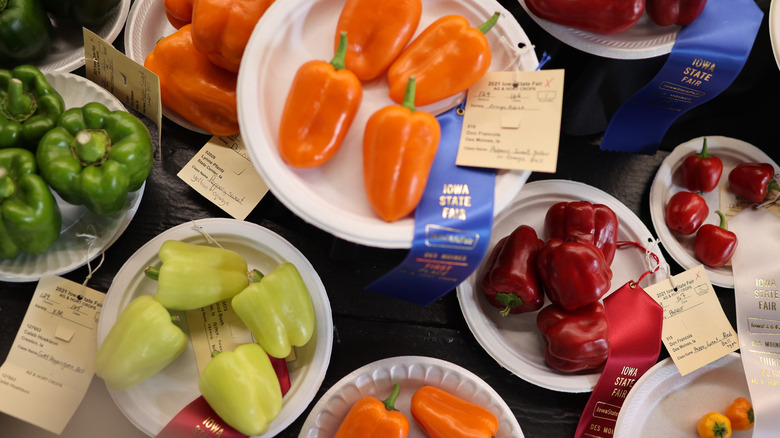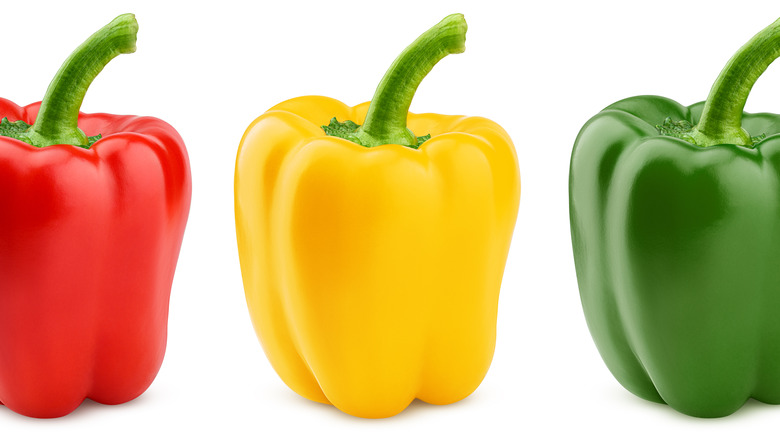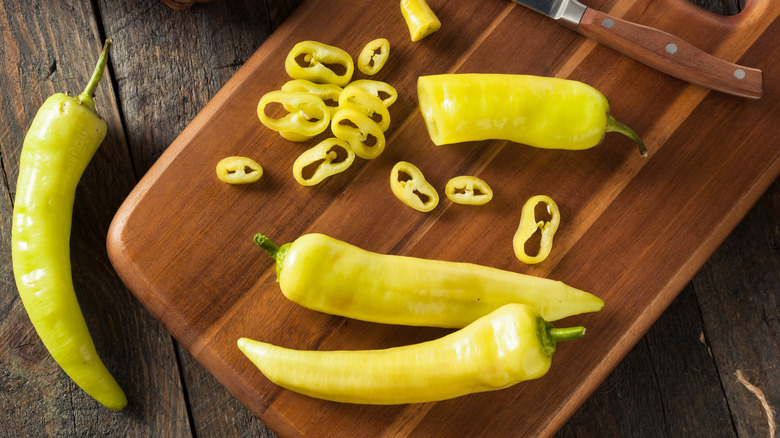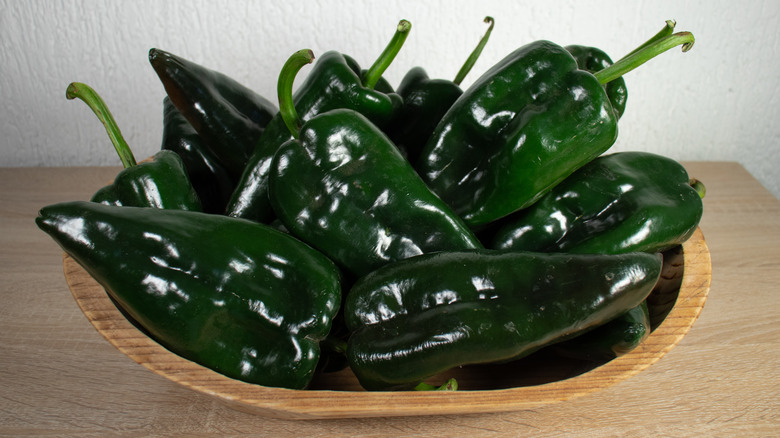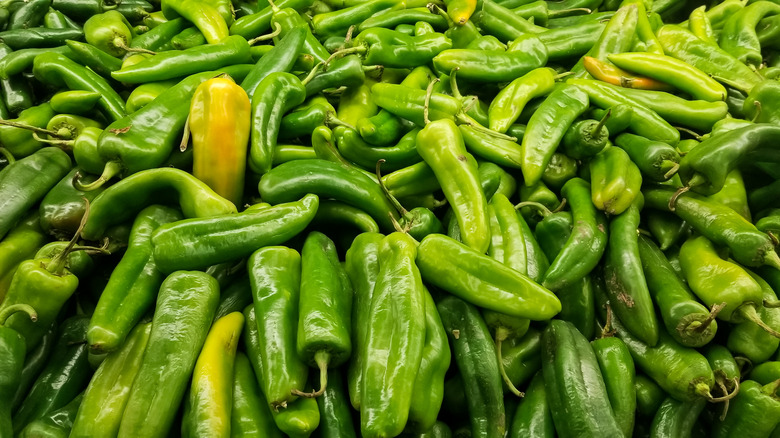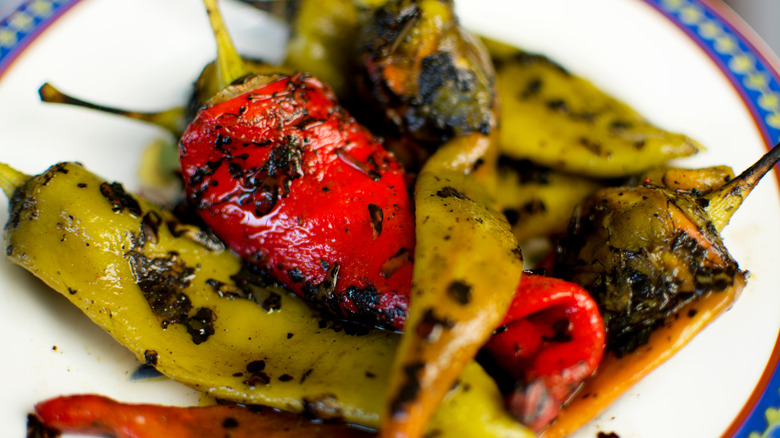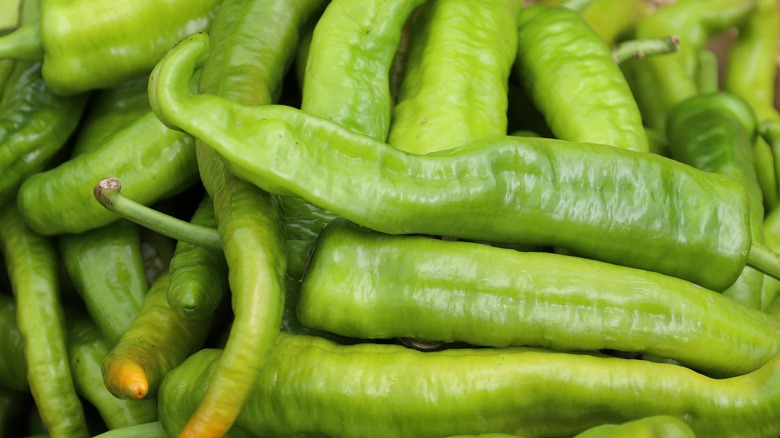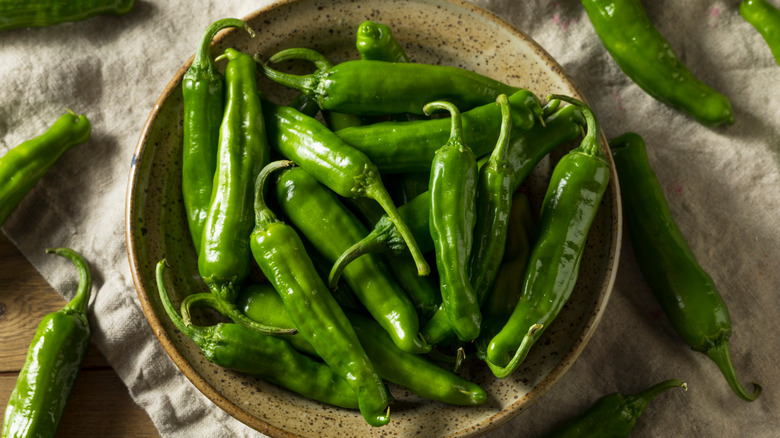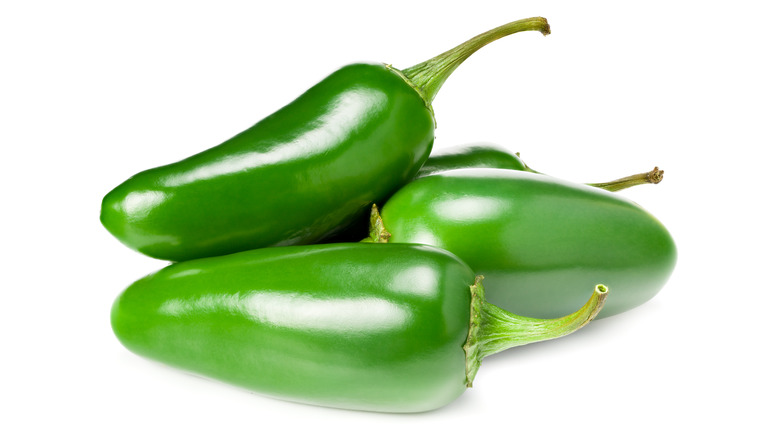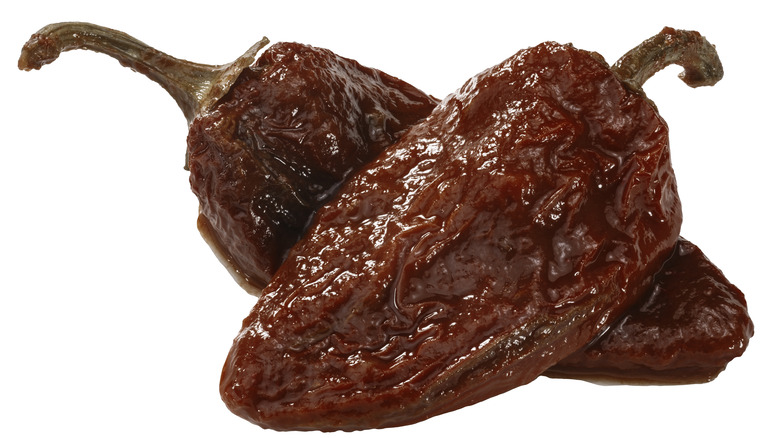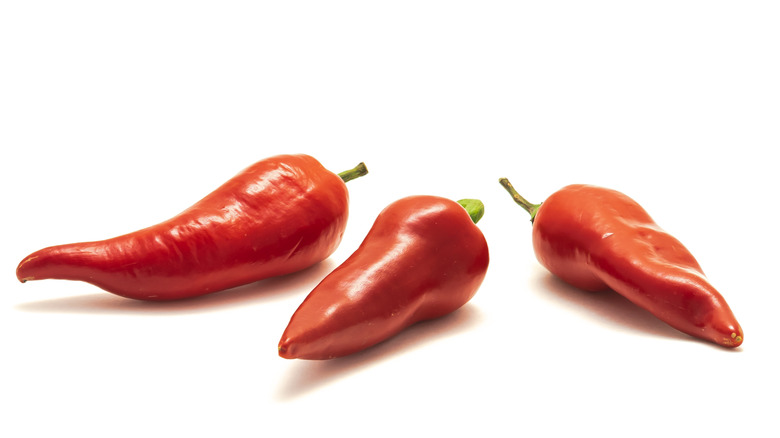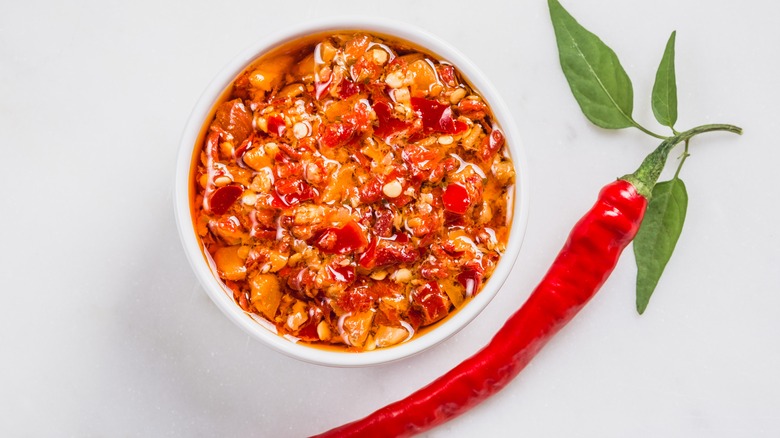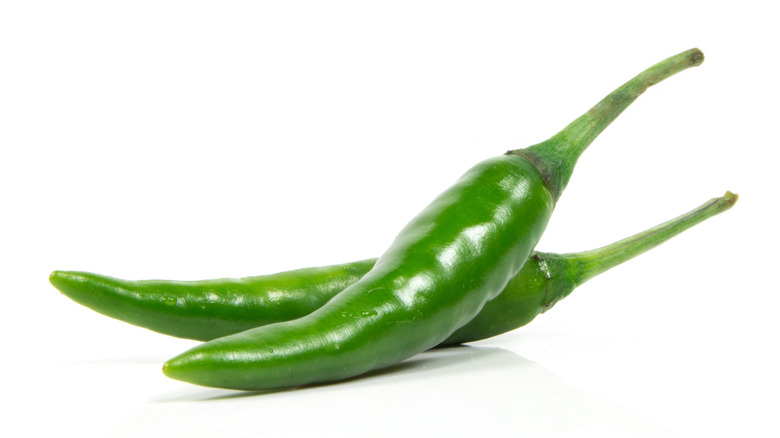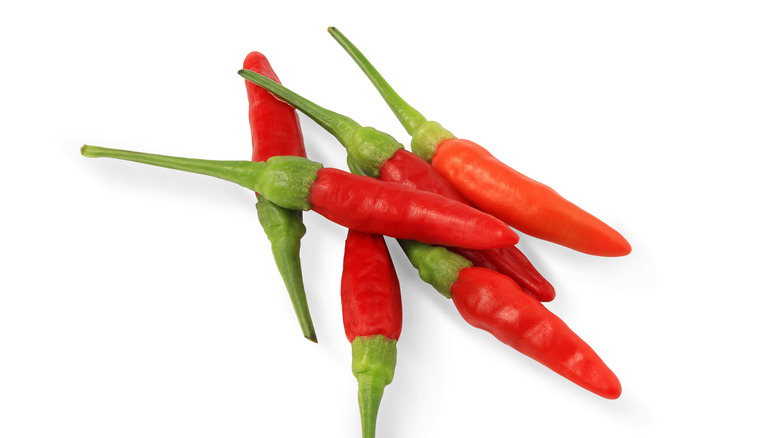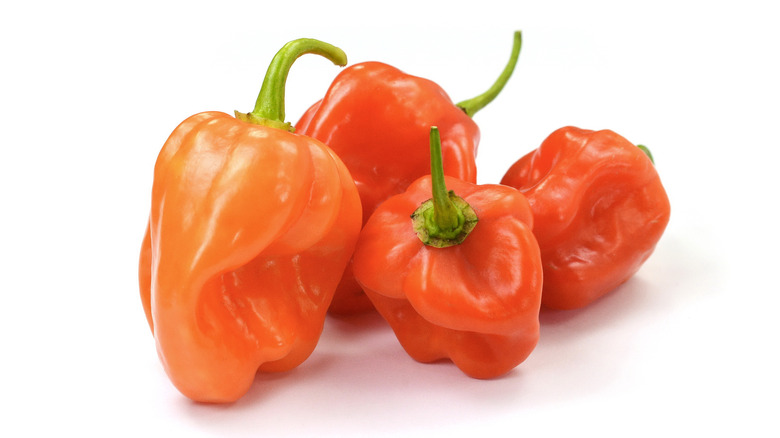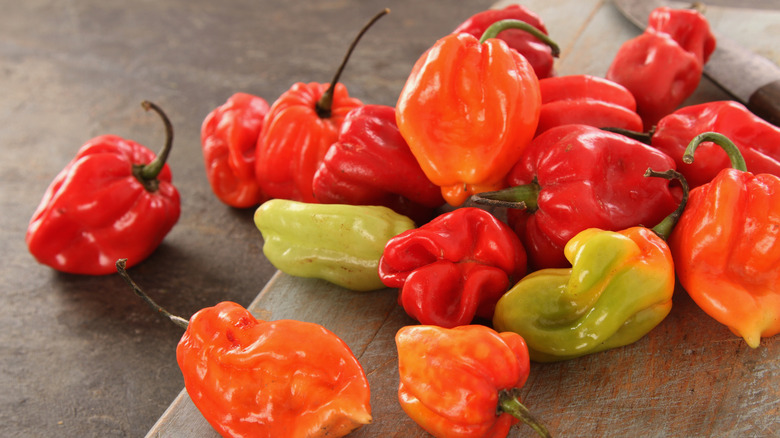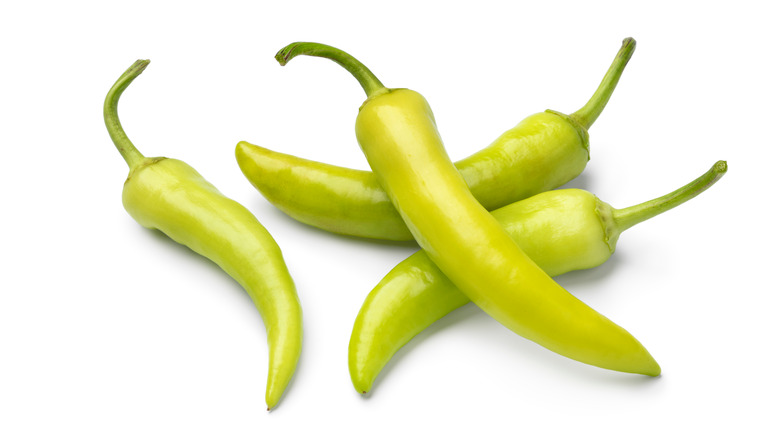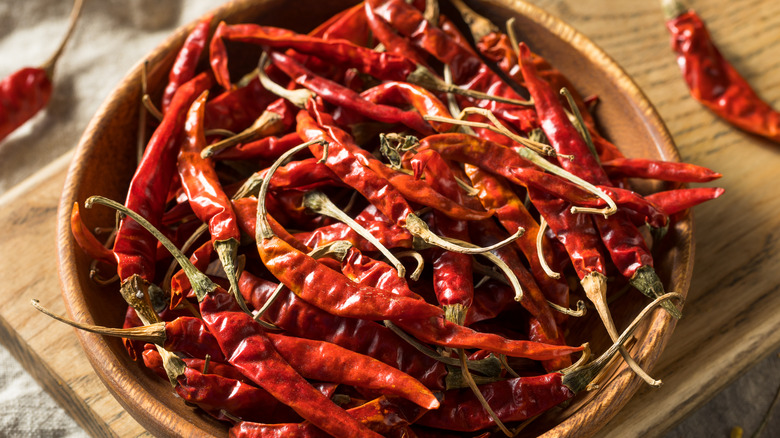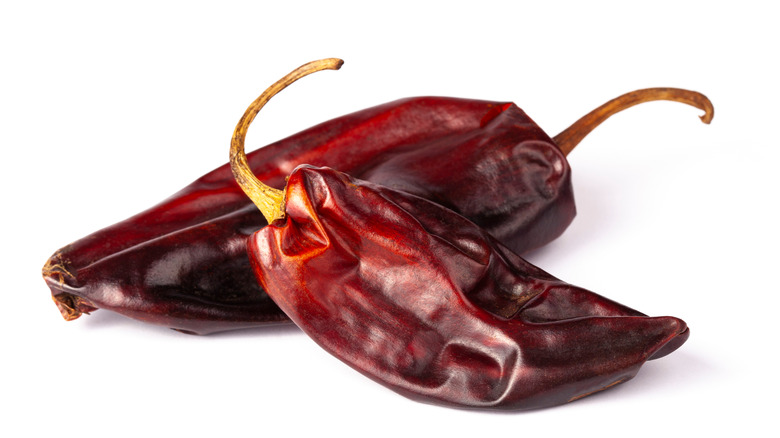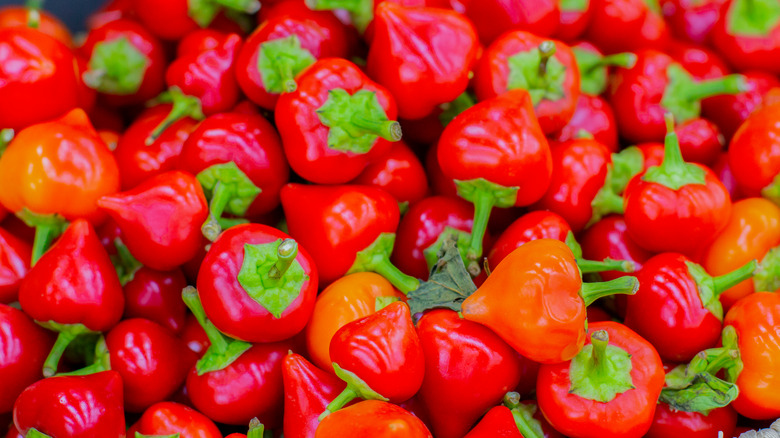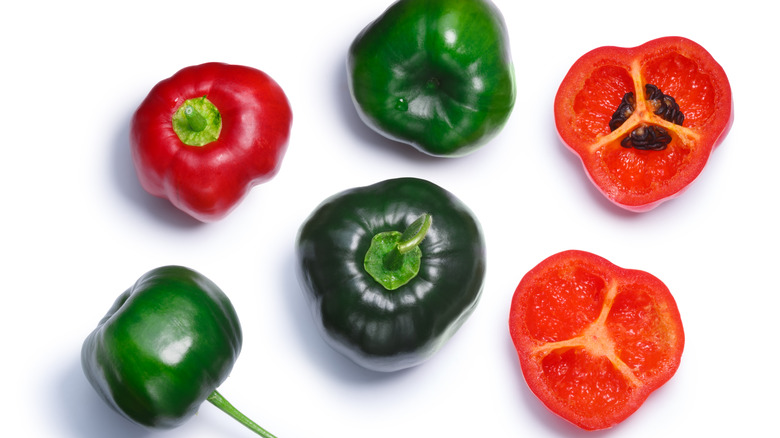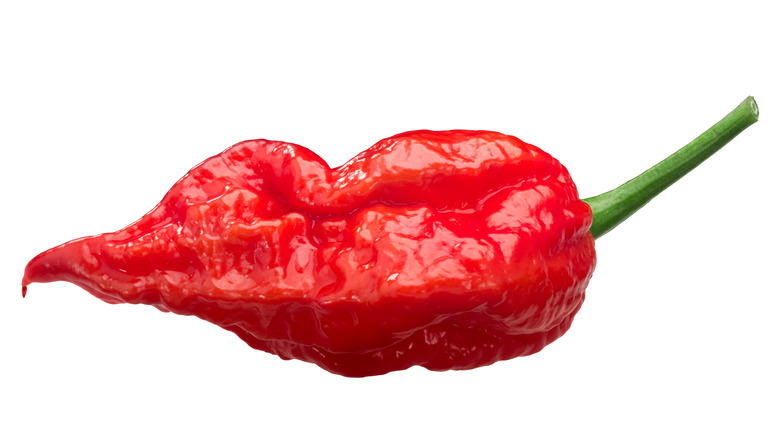21 Popular Types Of Peppers And What They're Used For
When you're cooking at home and looking for some extra flavor for your meal, peppers are a reliable ingredient to keep in your kitchen. But, with over 4,000 different types of chili peppers in the world, it's hard to determine which one to use. Not all peppers are alike: some have sweeter flavor profiles and others can pack a serious punch of heat. They also come in a variety of shapes, sizes, and colors.
There are different methods to distinguish peppers from one another — take the Scoville scale, for example, that numerically measures the spice levels of different chiles. But a simple number isn't the only factor to consider the next time you're in the produce aisle. Each pepper has its own special qualities that can upgrade any type of dish, so if you have trouble choosing between a jalapeño and a serrano, you're in luck! We created a guide to the 25 most popular peppers you can incorporate into your cooking.
1. Bell peppers
One of the most common peppers you can find at your local supermarket, bell peppers come in a rainbow of colors and vary in flavor from grassy to sweet. They may look different, but each color of bell pepper comes from the same plant — just at different stages of ripeness. Green bell peppers are the unripe fruit from the plant and have a vegetal, slightly bitter flavor. The other colors, like yellow, orange, red, purple, and striped Aloha peppers, are typically much sweeter because they had more time to ripen. No matter which bell pepper you choose at the supermarket, they'll add a sweet flavor to any dish without adding any extra spice. That makes them perfect vessels for stuffed peppers because they're larger in size and won't set your mouth on fire. You can also try slicing them and incorporating them into your next batch of fajitas or cheesesteaks.
2. Banana peppers
Banana peppers are an aptly named chile because of their long, yellow flesh that makes them resemble a banana. These medium-sized peppers sit at the bottom of the Scoville scale and aren't considered to be a hot pepper. According to Chili Pepper Madness, even the spiciest banana peppers are about five times milder than the weakest jalapeño. Also known as a yellow wax pepper, the banana pepper is a sweet, crisp, and flavorful addition to your culinary lineup and is extremely versatile. They're often served in Greek salads or as a pizza topping. You will most likely find banana peppers pickled and sliced into rings or stuffed with fillings on an antipasti plate. If you want to cook with peppers without worrying about incorporating too much heat, banana peppers are a great option. Try pickling them yourself and stuffing them into a sandwich for a bit of crunch.
3. Poblano peppers
Poblano peppers are another widely available option that have a similarly mild flavor to bell peppers. They are closest to green bell peppers in taste, but they are often less sweet and have thinner flesh. In addition, they're longer and more slender in appearance, with a pointed tip. Their name originates from the city of Puebla, Mexico, where the peppers were first grown. Spruce Eats notes that poblanos range from 1,000 to 2,000 on the Scoville scale, making them one of the less spicy peppers at your average grocery store.
They're often roasted and served in Latin American dishes, like chiles en nogada (the national dish of Mexico). Whenever you're looking to add a touch of earthiness to your dish, poblano peppers are a great option. For example, try adding some chopped poblano peppers when you're building a batch of chili to incorporate more depth of flavor without too much spice.
4. Anaheim peppers
Named for their Southern California hometown, Anaheim peppers are thick-fleshed, bright green peppers that have lots of flavor with minimal spice. In terms of taste, they are very similar to poblano peppers, but are slightly fruitier and a touch spicier. On the Scoville scale, Anaheim peppers normally fall within 500 and 2,500 — so while they can vary in heat, you can rest assured that Anaheim peppers will almost always be on the mild side. They're commonly used in chile rellenos, but you can roast them and incorporate their complex flavor to any sauce, soup, or stew. Another great application of Anaheim peppers is throwing them directly on the grill and developing a char on the outer flesh. When cooked, they develop a smoky, slightly sweet flavor that adds some extra nuance to fresh salsas. If recipes call for spicier peppers like jalapeño and serrano, you can swap them out with Anaheims if you want to mellow out the heat.
5. Hatch chilis
A biological cousin of the Anaheim, Hatch chile peppers actually come from the same seed. The difference between the two lies in the soil in which they're grown. Rather than ripening under the warm California sun, these peppers are grown in the Hatch valley of New Mexico. Because of the rockier soil and cooler climate, Hatch chiles have a fruitier flavor than their West Coast counterpart. You can't always find these peppers year-round, but when they are harvested in late summer, they make the perfect condiment for almost any dish. The green, unripe peppers are normally more vegetal while the red varietals have a more fruit-forward flavor. They can also be significantly spicier than Anaheim peppers, starting at around 1,000 Scoville units and some even surpassing 8,000 on the scale. If you can't find fresh Hatch chiles at the supermarket, check the Latin American aisle and grab a can of chopped chiles. They're best served in a batch of queso or piled high on a cheeseburger.
6. Cubanelle peppers
If you like the heat of Anaheim peppers but want a bit more sweetness, Cubanelle peppers are a great solution. These long, wrinkled chiles are sometimes referred to as Cuban peppers because of their origins in the Caribbean. You will most likely find these peppers used in Puerto Rican, Cuban, and Dominican dishes. They are often used as the base of sofrito, a paste made with tomatoes, peppers, and garlic that is an essential building block of soups and stews.
They typically stay at the bottom of the Scoville scale, with the spiciest peppers only reaching about 1,000 units. In terms of flavor and heat, they are most similar to Anaheim chiles or green bell peppers. Their mild, sweet flavor lends well to recipes where pepper is the star. Cubanelle peppers are an ideal chile to use for stuffed peppers. Just fill them with meat, rice, or any other preferred filling, then grill or bake them for a delicious yet simple weeknight meal.
7. Shishito peppers
Many common varieties of peppers originated in the Americas, but these tiny little peppers come from the other end of the world. The name comes from the Japanese word "shishi," translating to "lion," in reference to the curved, wrinkled appearance of the pepper. These Japanese peppers are small in size and usually fairly mild, but around one in 10 of them pack a surprising punch of spice. But, with most of them hovering at around 50 on the Scoville scale and the occasional hot pepper at 200 Scoville units, shishito peppers are generally one of the more mild options in the pepper aisle. You may not have cooked with these chiles before, but you may have seen them as a trendy appetizer at restaurants. Most commonly, they are blistered in a pan until they're soft and slightly charred. With just a simple squeeze of lemon and some salt, these peppers make for a delightful snack any time of year.
8. Jalapeño peppers
When most people think of peppers, jalapeños are probably some of the first to come to mind. These medium-sized, green chiles are moderately spicy and incredibly versatile in almost any kind of cooking. Jalapeño peppers range from 2,500 to 8,000 on the Scoville scale, but most of that spice comes from the seeds and pale white ribs inside the pepper. So if you want to incorporate some bright flavor without too much spice, scrape out the inside of the pepper before using it. They're an essential ingredient for fresh salsas like pico de gallo, but you don't only have to eat them when they're fresh. Jalapeños are commonly pickled and served on top of a sheet pan of nachos for some acidity and spice. Just like with most peppers, the flavor of the jalapeño is amplified when charred over a direct flame to develop a hint of smokiness.
9. Chipotle peppers
Although the name may be different, don't be fooled! Chipotle peppers are actually ripe jalapeño peppers that have been smoked. Smoking them over an open flame imparts a deeper flavor than fresh jalapeños. But just like the fresh version, Chipotles pack a moderate amount of spice. Their signature smoky taste is a staple in Tex-Mex and Mexican cuisine, and you can find them dried, powdered, or canned in adobo sauce.
If you want to incorporate some of their smokiness without adding too much heat, grab a can of chipotles in adobo and just add a bit of the pepper-infused sauce. A common application of chipotle peppers is in aiolis, and it couldn't be easier to make at home. Just mix store-bought mayonnaise with some chipotle and voila! You have a delectable condiment that's perfect in any sandwich. Next time you want to upgrade your enchilada recipe, throw in some chipotles for an added punch of flavor.
10. Fresno peppers
They may look similar to jalapeños, but Fresno peppers have a flavor all their own. They have a sweet, fruity taste and a medium spice level. They range anywhere from 2,500 to 10,000 Scoville units, so they can be a bit spicier than your average jalapeño. Another thing that distinguishes Fresnos from the more common jalapeño is their bright red hue. They're typically only about two to three inches long, but these peppers can pack a serious punch. One of the best ways to enjoy a Fresno pepper is by thinly slicing it and serving it raw. You can remove the seeds and ribs to minimize the impact of the spice. Their sweet, fruity flavor is especially delicious in fresh salads and salsas. Another perfect pairing is with seafood, especially in dishes like ceviche and fish tacos. No matter how you serve it, a Fresno pepper is bound to add a delightful amount of spice to any dish.
11. Calabrian chili peppers
These tiny peppers hail from Calabria in southern Italy and have long been a staple in their cuisine. In the United States, it's a lot harder to get your hands on fresh Calabrian chili peppers, but there's no need to worry. There are plenty of varieties of this fruity, spicy pepper that you can find at your average grocery store. The two most common ways Calabrian peppers are sold are in dried chili flakes or as a jarred, fermented condiment.
This pepper is an essential ingredient in Bomba sauce, where they're crushed and fermented into a bright and fruity relish. If you're looking to add some spice to pastas and pizzas and are sick of turning to your standard red pepper flakes, try Calabrian chili peppers instead! A spoonful of jarred Calabrians can upgrade your favorite arrabbiata sauce or maybe become your favorite topping for a slice of pepperoni pizza.
12. Serrano peppers
These small peppers look deceptively similar to their cousin, the jalapeño. But don't be fooled, serrano chiles pack some serious heat! They fall within 10,000 to 20,000 Scoville units, making them nearly five times hotter than your average jalapeño. To be safe, it's advised that you wear gloves when handling these peppers to avoid contact with your skin (or worse, your eyes!).
Their flavor is earthy and vegetal, but their spice level takes center stage on your tongue. Serrano peppers are commonly used in Mexican cuisine to add heat to salsa, pico de gallo, and guacamole. In addition, you can also find serranos used in Thai dishes like curry and stir-frys. If you love all things spicy, try swapping out jalapeños in recipes for these thin, green peppers. According to MasterClass, they also taste amazing as a pickled condiment in tacos and sandwiches, but beware! A little goes a long way with these super spicy chilis.
13. Bird's eye chilis
You might find these peppers at the supermarket and be fooled by their adorably small sauce. But bird's eye chili, also called Thai chili, have an intense heat that's anything but little. These peppers originate from, you guessed it, Thailand, and are named for their resemblance to the eyes of a bird. They are commonly used in stir-frys, curries, and larbs. If you want to add a punch of heat to soups and stews, smack a Bird's Eye chili a few times to release their natural oils and throw it directly into the broth. Then, after it infuses into your dish, fish it out just like you would for a bay leaf and enjoy the fruity, bright spice that comes from these tiny peppers. Alternatively, you can thinly slice these peppers and throw them into your next batch of lettuce wraps. Just make sure to be careful with how much you add to your recipes or risk a fire in your mouth!
14. Habanero peppers
Habanero peppers are some of the hottest peppers you can find at your average supermarket, and used to be one of the spiciest varieties on the planet! While they may have been dethroned by varieties like Ghost peppers and Carolina Reapers, these peppers should still be used with caution. Habaneros are typically small, unevenly shaped, and orange in color. Their flavor is dominated by their spice level between 100,000 and 350,000 Scoville units, but they also have bright, citrusy, almost tropical notes. That's why they're so common in cuisine along the Yucatan peninsula of Mexico, where bright flavors take center stage. Most of the time, you can find these peppers fresh in the produce aisle of your local supermarket. Habaneros can be an incredible ingredient when making homemade salsas and hot sauces, as long as you're careful with how much you use. And like with other super-hot chiles, you want to make sure to use gloves when handling them.
15. Scotch bonnet peppers
Scotch bonnet peppers are a cousin of the habanero, but are mostly used in an entirely different cuisine. Rather than adding heat to Mexican dishes, Scotch bonnets are one of the star ingredients of food in the Caribbean. They have a similar appearance and spice level to habaneros, but these peppers vary more widely in color. You can find these peppers in shades of green, orange, and red — just keep in mind that generally, the more vibrant the color, the spicier they are.
The hints of apple and tomato flavor in the pepper make them well-suited for dishes like jerk chicken and pikliz, a spicy Haitian pickled condiment. If you want to infuse some of its flavor while minimizing the spice, poke the pepper a few times with a fork and drop it into soups and stews. Make sure you fish out the pepper before serving unless you want to bite into a spicy surprise!
16. Hungarian wax pepper
These peppers are often confused with banana peppers. They may be similar in appearance, but be warned: these peppers are significantly spicier. Hungarian wax peppers are named after their waxy, crisp flesh. To nobody's surprise, these peppers originate from Hungary. Their spice level has a wide range, anywhere from 1,000 to 15,000 Scoville units. Before you use one of these in your next dinner, make sure to taste it first to determine how hot they are.
The flavor of Hungarian wax peppers is sweet and slightly tangy, making them perfect candidates for pickling. These peppers also taste great when they're cooked into soups, stews, and sauces. Alternatively, you can incorporate Hungarian wax peppers into marinades for fish or leche de tigre for ceviche. No matter how you prepare them, Hungarian wax peppers are bright, flavorful peppers that can add some fun variety to your usual lineup of peppers in your kitchen.
17. Árbol chiles
Chiles de Árbol are small, thin Mexican peppers typically sold dry at most American supermarkets. They are a vibrant shade of red with long, woody stems— which is why they're named "árbol," or "tree." Árbol chiles top out at around 30,000 Scoville units, making it comparable to serrano or cayenne pepper.
Since these peppers pack a large amount of heat in a small package, it is important to handle them with caution. That includes wearing gloves, washing your hands frequently, and avoiding contact with your eyes. Despite their intense spice and nutty flavor, they have a wide range of applications. They are a great pepper to add to your spice cabinet because you can use them in homemade dry rubs and seasoning blends. One of the best applications for chiles de Árbol is in a salsa macha, a salsa made with dried chiles, nuts, and oil. To amplify their flavor, try toasting them before using them in your next recipe.
18. Guajillo chiles
Another dried pepper to look for on your next trip to the supermarket is the guajillo chile. Pronounced "gwa-hee-yo" in Spanish, this chile is the dried form of the mirasol pepper. While mirasol peppers are much harder to find stateside, you can still get a taste of their fruity, complex flavor without a trip to Mexico. These peppers range from 2,500 to 5,000 on the Scoville scale, making them similar in spice to the average jalapeño pepper. However, their flavor is very distinct.
There are berry-like notes with a hint of smoke and moderate heat. Their nuanced flavor palette is the primary reason why guajillo chiles are used as the base of sauces, moles, and stews. If you're looking to upgrade recipes that call for chili powder, swap it with some guajillo peppers. Try toasting them for maximum flavor then pulverizing them in a blender. Once you taste how deep and rich your recipes can be with these peppers, you may never go back to the pre-ground stuff again.
19. Cherry peppers
Cherry peppers are small, round peppers that resemble, you guessed it, cherries. And just like their namesake, these peppers have a hint of sweetness. Their texture is crisp and the thick flesh adds a delicious crunch to home-cooked meals. Their heat level is similar to a mild jalapeño pepper with a Scoville rating of around 3,750. Not all supermarkets carry fresh cherry peppers in the produce aisle, but you're bound to find them alongside olives in the preserved-foods section or at salad bars.
Cherry peppers are mostly served as a pickle to accompany cheese boards or to pack in a sandwich. Because of their naturally thick skin, these peppers lend well to pickling because they retain their crisp texture. They are best served on an antipasto platter, but Spruce Eats also recommends chopping them up and mixing them into burgers, meatballs, and meatloaf for a burst of flavor with moderate spice.
20. Rocoto peppers
Although Rocoto chiles resemble bell peppers with their shape and variety of colors, be careful! They are significantly spicier than their more commonly sold cousin. One distinct visual difference with Rocoto chiles is their black seeds. Spruce Eats describes their flavor as a cross between an apple and a tomato with a burst of serious spice, ranging from 30,000 to 100,000 Scoville units.
These fiery hot peppers resemble habanero and Scotch Bonnet peppers in terms of spice, but have their own unique origins. Rocoto chiles were first grown in the Andes mountains in Peru, and the cold, rocky climate gives them a thick, juicy flesh. They are an integral part of Bolivian and Peruvian cuisine, like traditional stuffed rocotos rellenos. Rocoto peppers are also a delicious addition to a stir-fry or homemade salsa. Just be cautious with how much you use to avoid giving your friends and family a spicy surprise.
21. Ghost peppers
The ghost pepper is famously one of the spiciest varieties in the world, and the title is more than deserved. These chiles can reach over a million Scoville units, making it over three times hotter than your average habanero pepper. Ghost peppers, also known as Bhut Jolokia, are primarily grown in northeastern India and Bangladesh and are named for how their intense heat creeps up on your palette like a ghost. When you first take a bite, you initially taste their sweet, fruity flavor. After about 30-45 seconds, however, the heat starts to dominate your palette and can linger for around half an hour. Some of the ghost pepper's heat resides in the seeds and ribs inside the chile, but their thin, wrinkly skin still packs a serious punch of heat.
These peppers are usually not available at regular supermarkets, so you'll have to source them online if you want to try them. Their most common application is in homemade hot sauces, but they're best when combined with other milder chiles to balance their spice.
